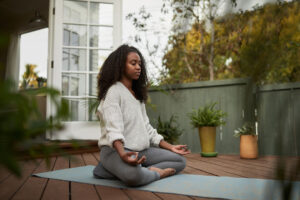Find out why over-exposure to blue light affects your ability to fall asleep and the quality of sleep you get.
Whether it’s looking at a computer, watching TV, using a tablet, or playing on your smartphone, the average American adult spends 10-12 hours a day looking at a screen. Teens aren’t far behind, clocking in 8 hours of screen time. And children ages 8 to 10, spend around 6 hours a day in front of a screen.
Not only does this hurt how active we are throughout the day—wreaking havoc on our bodies, it also affects our brains. And one of the key culprits behind it is blue light.
What is Blue Light?
Blue light is everywhere. In fact, a lot of what we see during the day is blue light from the sun. It’s what makes the sky blue. It keeps us in sync with our natural environment. It tells our bodies when to wake up and go to sleep (circadian rhythms). And, it helps boost our energy levels, alertness, moods, reaction times and overall feeling of well-being.
In the past, the only exposure people had to blue light was in the sun during the day. Artificial blue light like we see in LED bulbs, fluorescent lighting, TVs, tablets, computers, smartphones, and gaming systems, changed that… and it hasn’t always been for the better.
How artificial blue light affecta your body
Over-exposure to blue light can affect your body’s ability to fall asleep as well as the quality of sleep you get. The reason behind this is that blue light has short wavelengths that delay the release of melatonin, a hormone that helps your body regulate its sleep-wake cycle.
Typically, your body starts producing melatonin 2 to 3 hours before bedtime. When that process is delayed, it can take you even longer to fall asleep and disrupt the amount of REM sleep your body gets throughout the night. This will leave you feeling tired in the morning, even if you slept for a full eight hours.
How to protect yourself from blue light
The easiest thing to do to get a better night’s sleep is power down. Try to avoid all screens two to three hours before bedtime so your body can start producing melatonin. If that’s not possible, adjust your screen to have the blue shade or night light on. This brings out the red and yellow light waves (like you would see at sunset) rather than blue.
If the use of digital devices is necessary in the evening, you may want to invest in a pair of blue-blocking glasses. Also, avoid using energy-efficient blue lights in your bedroom and bathroom. Instead, use dim red lights that have higher wavelengths and won’t suppress the release of melatonin.
More Ways to Get a Better Night's Sleep

Get more peaceful days and restful nights! A unique 2-in-1 formula that is 100% hormone-free, Relax & Calm helps reduce stress and the feeling of being overwhelmed all while enhancing your quality of sleep. Clinical studies show that valerian root, a key ingredient found in Relax & Calm, often works faster than melatonin, common sleep aids, and anti-anxiety drugs without the negative side effects.
You can also ask your local AlignLife Chiropractor how spine health, nutrition, and daily activity can help.



